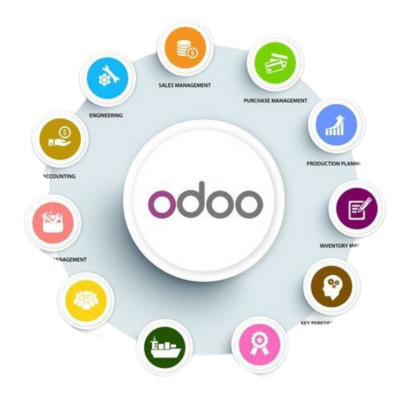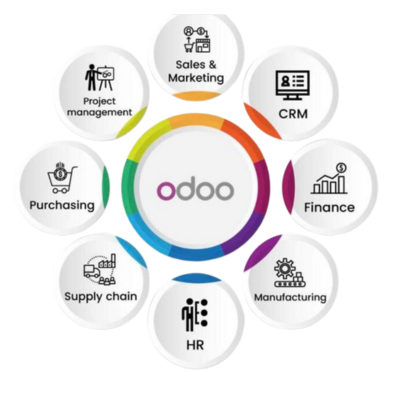Introduction
Integrating Odoo with your existing software stack can enhance operational efficiency, improve data flow, and streamline business processes. Odoo’s flexibility allows it to connect with various applications—CRM, eCommerce platforms, accounting systems, and more. In this guide, we explore the key steps, best practices, and practical solutions for integrating Odoo into your current software environment.
Supercharge Growth with Odoo Experts!
Tailored Odoo Solutions for Streamlined Business Efficiency and Growth

Benefits of Integrating Odoo with Other Systems
- Unified Data Management: Centralizes data from multiple sources, improving accessibility and accuracy.
- Automated Workflows: Reduces manual data entry and eliminates duplication across systems.
- Enhanced Collaboration: Enables seamless data sharing among departments.
- Improved Reporting: Provides a comprehensive view of business metrics for informed decision-making.
Key Integration Steps
- Assess Integration Requirements
- Purpose: Identify key systems and data flows to ensure a seamless connection.
- Best Practices:
- Define Integration Goals: Determine what processes need to be automated and which data should flow between systems.
- Select Key Modules: Focus on the core Odoo modules (e.g., Sales, CRM, Inventory) that will integrate with your software stack.
- Benefits: Clear integration goals prevent misalignment and ensure a smooth setup.
- Select the Right Integration Method
- API Integration: Ideal for real-time data sync between Odoo and other applications.
- Third-Party Connectors: Leverage connectors for popular platforms (e.g., Shopify, QuickBooks).
- Custom Integration Scripts: Tailored scripts for unique software needs.
- Benefits: Choosing the correct method saves time and minimizes compatibility issues.
- Map Out Data Fields and Workflows
- Purpose: Align data fields and workflows between systems to ensure consistency.
- Best Practices:
- Field Mapping: Match fields like “Customer Name” or “Product ID” across systems to maintain data accuracy.
- Set Workflow Triggers: Automate actions (e.g., creating an Odoo sales order when a Shopify order is placed).
- Benefits: Avoids data discrepancies and improves automation reliability
Integration Solutions for Odoo
Odoo provides several built-in connectors and tools for common integrations, making it easier to connect with widely-used platforms:
- Odoo Connector for eCommerce (e.g., Magento, WooCommerce): Automatically syncs product catalogs, orders, and customer information.
- Odoo Accounting Integrations: Connects with accounting software like QuickBooks and Xero.
- Zapier Integration: Allows no-code integrations with hundreds of third-party apps.
These solutions can reduce setup time and offer quick connections between Odoo and external systems.
Get expert help with Odoo!
Boost efficiency with expert Odoo consulting today!

Custom Integration Tips for Key Systems
System | Integration Tips | Benefits |
CRM | Sync leads, opportunities, and contact information | Enhances customer insights and engagement |
eCommerce | Real-time sync of orders, inventory, and customer data | Streamlines order fulfillment and stock management |
Accounting | Map invoices, payments, and financial data | Reduces manual entry and maintains financial accuracy |
ERP/WMS | Sync inventory and supply chain data | Improves supply chain visibility |
Advanced Integration Options
- Real-Time Data Sync with API
- Purpose: Synchronizes data instantly across systems, ideal for dynamic environments.
- Best Practices:
- Set Rate Limits: To prevent overloading systems during data sync.
- Error Logging: Capture and track errors for easier troubleshooting.
- Benefits: Real-time data availability boosts accuracy and speeds up processes.
- Batch Data Processing
- Purpose: Useful for large data sets, such as nightly inventory updates.
- Configuration Tip: Schedule syncs during off-hours to avoid affecting system performance.
- Benefits: Efficiently manages large volumes of data without disrupting daily operations.
- Role-Based Data Access
- Purpose: Restricts data visibility based on roles to enhance security.
- Best Practices:
- Set Permissions: Control who can access or edit data across integrated systems.
- Mask Sensitive Data: For fields like financial or personal information.
- Benefits: Ensures data privacy and complies with regulatory requirements.
Expert Odoo ERP Solutions Provider
Hire Expert Odoo Developers for Tailored ERP Solutions Today!

Best Practices for a Smooth Integration Process
- Comprehensive Testing
- Test each integration module to ensure data accuracy and workflow consistency.
- Benefit: Minimizes risks of data errors or process misalignment post-launch.
- User Training
- Train employees on integrated workflows and new data entry points.
- Recommendation: Provide role-specific training to boost adoption and efficiency.
- Monitoring and Maintenance
- Schedule regular checks on data sync and workflow automation.
- Benefit: Detects issues early and maintains smooth data flow across systems.
For companies seeking expert integration solutions, an Odoo Development Company can provide tailored support for setting up, customizing, and managing integrations that suit your unique business needs.














